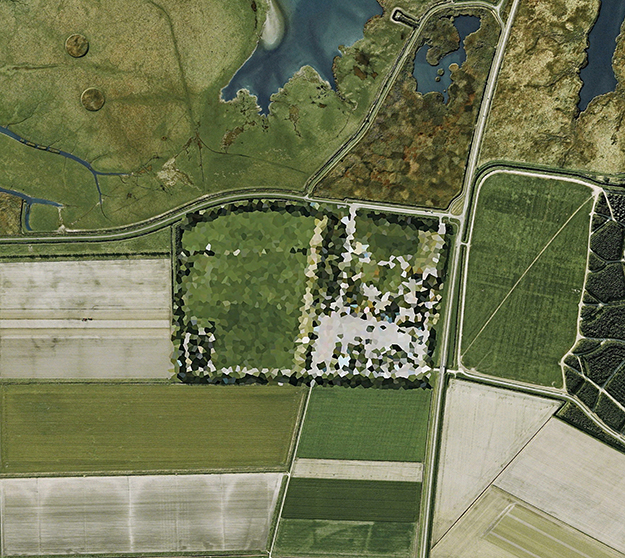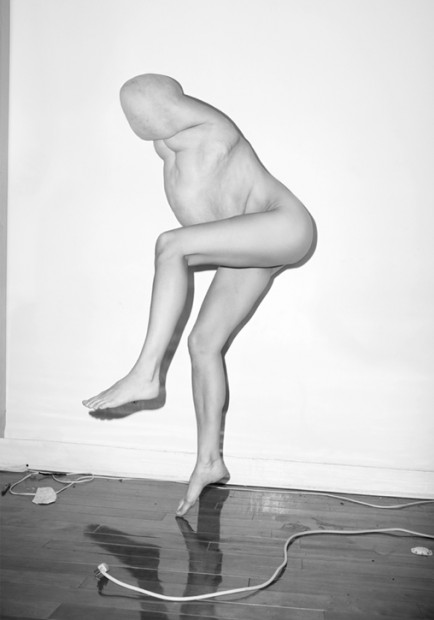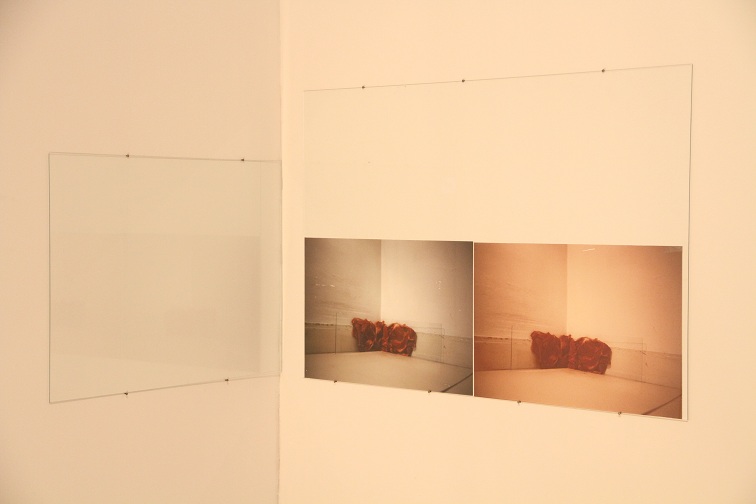Mishka Henner, Dutch Landscapes, 2011
So, it’s been about a month since the Dallas Art Fair weekend and all the very good independent shows and events that surrounded it. That was an incredible weekend, if I may lend my opinion on it – a game changing, finally-Dallas-is-getting-it’s-shit together, high-five-worthy weekend of friction and art density that felt totally legitimizing. It was cool to read the Art Forum blog post about the high-end aspects of the weekend, which were very good; though, I was, admittedly, a bit saddened that the author, Linda Yablonsky, didn’t get a chance to meet many local artists or up-starts, as she admits in the piece: “…the evening’s program also included the opening of Erick Swenson’s solo project at the Nasher. That’s when I realized he was the only local artist I had come across as yet. Was Dallas the only city in the world where the collectors outnumber the artists?” Well, no, but I can understand the confusion. There was so much to do that weekend that it was hard to do it all, and most of us that were participating in events or staging them couldn’t make it to everything. That was a good problem to have, sez I. And it was also incredible that what did happen independently by locals was top-notch.
One such thing, as you’ve heard tell by now, was the Dallas Biennial – not the one run by the Dallas Contemporary, but the other Dallas Biennial run by artists (and studio mates) CJ Davis, Michael Mazurek and Jesse Morgan Barnett. Their exhibition of international work in the 300 square foot space in the back of Oliver Francis Gallery was an intense chamber of provocation and insight, culling from artists all over the world, with new work and older stuff. The online component of Dallas Biennial, though, called DB12, is the real, time-out-of-time treasure trove. From the DB12 manifesto: “DB12 is an amalgam: part event, part research, part data, part publication. It will comment on, and create discourse in, notions of objecthood (or lack thereof) counterpoint, displacement, multiplicity, media and socio-technological archaeology. Our vision is that DB will examine the question of what an international exhibition might look like without the constraints of location and time.”
UT Arlington professor and art critic, Dr. Ben Lima, wrote one of the accompanying essays for DB12’s online catalogue. (Soapbox sidenote: Dallas’ art-savvy often kvetch about the lack of a real art critic in town, by which I think they mean an intelligent and fresh art historian that can cull from the annals of art history yet still write in a way that regular people can understand. Ahem: meet Ben Lima.) Lima’s title for his thoughtful essay for DB12’s site is a question: “Can electronic media in general, and the web in particular, generate a sense of place, for example one that corresponds to the concept ‘Dallas’?” The essay opens up an erudite and compelling unpacking of DB12’s physical and online components, which are vast, ultimately suggesting that: “As a fast-growing and future-oriented, if not amnesiac city, Dallas sometimes seems to have more in common with boomtowns like Shanghai or Dubai than with the staid and venerable cradles of art history. The work in DB12, however, reminds us that such distinctions are never so simple. In both its web and its physical presence, DB12 is a complement and a challenge to the official identity of Dallas.”
Ager Carlsen, Hester
Lima is right to pinpoint, throughout his essay, the sticking points of Dallas’ identity — its wideopen, sprawling geography and the subesequent lack of archetypal urban and intellectual cohesion that other cities take for granted — and to use those things as a way of describing the scope and relevance of the DB12’s project to expand the idea of a contained international exhibition. Dallas as the hub for a wide-reaching, technology-dependent art show seems, as Lima suggests, entirely fitting.
As an internet exhibition, I was gobsmacked by how thorough and investigative the DB12 site is. It’s curatorial vision, its layout and functionality, and the incredible detail to which Barnett, Davis and Mazurek plumbed each topic and artist are all expert. Each artist’s page provides a wide array of research on their work by way of essays, statements, renderings, and links for more information on their work. I found myself doing some real learning while on the site, and getting lost in the maze of multifarious means we have at our disposal when it comes to consuming art these days. And by “consuming it” I mean looking at it, receiving it, and letting it store up inside you somewhere for processing at your own leisure and delight.
Also, be sure to check out DB12’s film screening of Robert Smithson’s Spiral Jetty; Nam June Paik’s Good Morning Mr. Orwell, Documenta 6 Satellite Telecast, and Lake Placid ’80; Artur Barrio’s Situations, T/T 1; Lou Mallozzi’s Peers (sound) on Thursday, May 31, at 7pm at The Texas Theater. More info here.
Arturo Barrio, Meat Skirting Boards, 1978






2 comments
The Dick Higgins Gallery was smart and refreshing and it was great to read your thoughts on it. DB12 is such a boon to the activities happening in our metroplex right now!
LSD25: The Best Little Web-Show in Texas
So, it’s been about a month since the PLANO Art fair weekend and all the very good independent shows and events that surrounded it. That was an incredible weekend, if I may lend my opinion on it – a game changing, finally-PLANO-is-getting-it’s-shit together, high-five-worthy weekend of friction and art density that felt totally legitimizing. It was cool to read the Art Forum blog post about the high-end aspects of the weekend, which were very good; though, I was, admittedly, a bit saddened that the author, Linda Yablonsky, didn’t get a chance to meet many local artists or up-starts, as she admits in the piece: “…the evening’s program also included the opening of AXEL THE AXE ROSE’S solo project at the Nasher. That’s when I realized he was the only local artist I had come across as yet. Was PLANO the only city in the world where the collectors outnumber the artists?” Well, no, but I can understand the confusion. There was so much to do that weekend that it was hard to do it all, and most of us that were participating in events or staging them couldn’t make it to everything. That was a good problem to have, sez I. And it was also incredible that what did happen independently by locals was top-notch.
One such thing, as you’ve heard tell by now, was the PLANO Biennial – not the one run by the PLANO Contemporary, but the other PLANO Biennial run by artists (and studio mates) CJ Davis, Michael Mazurek and Jesse Morgan Barnett. Their exhibition of international work in the 300 square foot space in the back of Oliver Francis Gallery was an intense chamber of provocation and insight, culling from artists all over the world, with new work and older stuff. The online component of PLANO Biennial, though, called LSD25, is the real, time-out-of-time treasure trove. From the LSD25 manifesto: “LSD25 is an amalgam: part event, part research, part data, part publication. It will comment on, and create discourse in, notions of objecthood (or lack thereof) counterpoint, displacement, multiplicity, media and socio-technological archaeology. Our vision is that DB will examine the question of what an international exhibition might look like without the constraints of location and time.”
UT Arlington professor and art critic, Dr. Ben Lima, wrote one of the accompanying essays for LSD25’s online catalogue. (Soapbox sidenote: PLANO’ art-savvy often kvetch about the lack of a real art critic in town, by which I think they mean an intelligent and fresh art historian that can cull from the annals of art history yet still write in a way that regular people can understand. Ahem: meet Ben Lima.) Lima’s title for his thoughtful essay for LSD25′s site is a question: “Can electronic media in general, and the web in particular, generate a sense of place, for example one that corresponds to the concept ‘PLANO’?” The essay opens up an erudite and compelling unpacking of LSD25’s physical and online components, which are vast, ultimately suggesting that: “As a fast-growing and future-oriented, if not amnesiac city, PLANO sometimes seems to have more in common with boomtowns like Shanghai or Dubai than with the staid and venerable cradles of art history. The work in LSD25, however, reminds us that such distinctions are never so simple. In both its web and its physical presence, LSD25 is a complement and a challenge to the official identity of PLANO.”